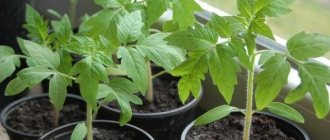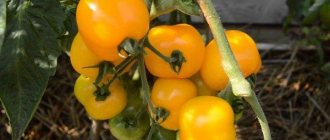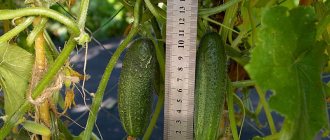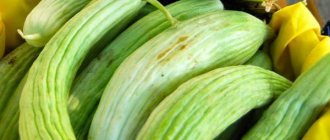Choosing a variety for growing carrots in a greenhouse
Agricultural technology for carrots in a greenhouse differs from growing the crop in open ground.
In a greenhouse, the root crop ripens quite quickly. Early varieties are chosen; the packaging of the seeds should have a mark indicating the possibility of growing in shelter. The best varieties for the greenhouse are:
- Minicore: root vegetables up to 20 cm, sweet taste.
- Mokush: vegetables are large, cylindrical, sweet, juicy.
- Nantes spruce: medium-sized bright orange fruits, suitable for eating raw.
- Mokum: a root vegetable with a pleasant smell and taste, one of the earliest in the group.
- Amsterdam Forcing 3: smooth elongated vegetables, ideal for canning and storage.
- Minicore: small fruits, crunchy, sugary.
- Nantskaya-4: elongated root crops for universal use differ in their shelf life.
Greenhouse requirements
began to grow carrots in greenhouses relatively recently; the usual method seemed simpler and more familiar, when planting is done in early May or before winter, but now greenhouse cultivation has also become widespread
This can be a standard polycarbonate structure, or covered with film.
The main thing is to ensure that there is sufficient ventilation in the greenhouse and how much light enters it, but this already depends on the correct location.
Advantages and disadvantages of growing carrots in a greenhouse without seedlings
Carrots can be sown directly into prepared soil or seedlings can be pre-grown. Growing root vegetables from seeds has its pros and cons.
| Advantages | Flaws |
| Sprouting from a seed in the ground provides a large harvest | Thinning of seedlings required |
| Vegetables sown in greenhouses do not produce lateral branches of the root crop | Labor intensity of weeding |
| Minimum labor costs | The plant gets sick more and is affected by pests |
| Carrots planted from seeds last longer | The growing season increases by 30 days |
| Young seedlings are not damaged during transplantation | High consumption of seed material |
Features of care
Proper care of carrots has a significant impact on the quality of root crops and yield. In order to properly care for this vegetable crop in a greenhouse, you should remember that the technology for cultivating carrots involves the following activities:
- timely and high-quality thinning of seedlings and plants several times a season;
- regular shallow loosening of the upper soil layers;
- periodic hilling of vegetable crops;
- thorough and timely removal of all weeds;
- regular and sufficiently abundant watering of carrots and fertilizing with complex fertilizers;
- carrying out preventive measures and timely control of pests and diseases of vegetable crops.
You can also learn about the features of growing beets in greenhouse conditions.
Rules for growing carrot seedlings
It is not difficult to obtain strong and healthy seedlings of garden crops. Carrots do not require special care. It is important to take into account the timing of planting, prepare the seed, and provide heat and light to the seedlings.
Seed preparation
Seed material comes in the following types:
- Seeds in bulk.
- Seeds on a ribbon. Glued at equal distances. Thanks to this, the seedlings do not require thinning, but appear later. The glued seeds are dry, there is no way to soak and feed them.
- Dried. Seeds coated with a shell containing useful substances. Such material does not require pre-sowing preparation. The soil must be thoroughly moistened so that the shell disintegrates.
Seeds of root crops, regardless of variety and type, have low germination (50-75%). Only fresh seeds are selected for sowing.
The sprouts sprout unevenly. The seeds are covered with essential oils that do not allow moisture to pass through. Until the oils are washed away from the seed, germination slows down.
To increase germination and accelerate seedling growth, seed preparation measures are carried out:
- Disinfection and increasing germination. The seeds are soaked in a weak solution of manganese, using “Epin”. Soak for half an hour, after which the floating empty seeds are taken out and thrown away.
- Hardening. The seed material, wrapped in damp gauze, is placed in the refrigerator for 5 days. You can bury the seeds in open cold ground for 10 days.
- Drying. The seeds are washed and left on a clean, dry surface for 20-30 minutes. After drying, the seeds are immediately sown.
Note! Carrots can be sprouted before sowing. To do this, the seeds are mixed with peat and left for a week. After pipping, the sprouts are sown in containers.
Dry seeds should swell and become saturated with moisture during processing. During hardening, humidity must be controlled.
Timing of sowing seeds
Seedlings germinate 6-20 days after sowing. After 2 weeks, the seedlings can be moved to the greenhouse. The temperature should not drop to sub-zero values. The timing of sowing depends on the region and the availability of heating in the greenhouse.
| Sowing time | Note |
| Second half of April | Northern regions |
| From late February to mid March | Southern regions |
| Second half of March - early April | Middle lane |
| Beginning of May | The greenhouse does not have a heat-insulating coating |
| Early February | Heating in the greenhouse, warm beds |
Proper planting of seeds for seedlings
Algorithm for sowing root crop seeds:
- Prepare containers: planting boxes, plastic containers. Experienced gardeners say that it is better to sow seeds in empty chocolate boxes. This will make the root vegetable sweeter.
- Prepare the soil. Take universal soil for seedlings, sandy loam from the site, mix garden soil, peat, humus.
- Treat the soil with a disinfectant (manganese solution).
- Fill the containers with soil mixture. Layer height – 25 cm.
- Moisten the soil in the containers.
- Sow the seeds:
- pour in bulk, sprinkle with a thin layer of earth (after sprouting, picking will be required);
- piece by piece, with your hands or tweezers, bury the seed 2 cm into the ground (the distance between the holes is 3 cm).
- Moisten the soil with a spray bottle.
- Cover the container with film.
The containers are placed in a room with a temperature not lower than +2 °C. The film is removed several times a day for ventilation and condensation is removed. Moisten the soil if it dries out. As soon as the sprouts hatch, the film is removed.
Caring for carrot seedlings in a greenhouse
| Parameter | Description |
| Temperature | +16…+23 °С |
| Lighting | The plant needs full lighting (9-12 hours a day). On cloudy days, phytolamps are used. |
| Watering | 1-2 times a week depending on climatic conditions. Water consumption: 3-4 l/1 sq. m. |
| Thinning | After emergence of seedlings in areas of dense plantings, weak, small seedlings are carefully removed |
| Adding soil | If the seed sowing rules have been followed, no additional soil is required. |
| Picking | Densely sown seedlings are planted using the transshipment method or using a peak or spatula. Before the procedure, thoroughly moisten the soil so as not to damage the rhizome. Planted in separate containers or in a common box. The distance between seedlings should be at least 3-4 cm. |
| Top dressing | 10 days before transplanting, water with a mixture of fertilizers: potassium (15 g), superphosphate (15 g), ammonium nitrate (12 g), 5 l of water |
| Hardening before planting | The room with seedlings is ventilated daily, gradually increasing the interval to 8-10 hours. |
Transplanting carrot seedlings into a greenhouse
The seedlings are transplanted into the greenhouse after the appearance of the first true leaf.
Selection of location and soil
The greenhouse in which root crops are planted must be well ventilated. The greenhouse should not be located in a low area, in a dark place. Carrots love light, loose, crumbly soil. There should be no impurities or lumps in the soil. The root crop does not like large amounts of sand, clay, or high acidity.
After which it is better to plant carrots
The root crop grows well in soil where cucumbers, tomatoes, and legumes grew last season. In open ground, the vegetable is planted after potatoes, cabbage, and onions.
You should not grow garden crops after parsley, celery, and zucchini. Carrots bear fruit best next to tomatoes, garlic, and green salad.
Do not plant carrots in the same place as last season. The break should be 4-5 years.
Soil preparation
It is better to prepare a bed in a greenhouse in the fall:
- remove all waste, dig the soil with a shovel to a depth of 25-30 cm;
- treat the soil with a 3% solution of Bordeaux mixture for disinfection;
- add a bucket of humus, rotted sawdust, peat, a mixture of phosphorus and potassium to the soil;
- if the soil is acidic, add dolomite flour and lime (300 g/1 sq. m).
Note! Organic matter is added in the fall. Fertilizers applied in the spring can burn the rhizome, and the carrots will grow gnarled.
In spring, the soil is loosened and leveled with a rake. The soil can be disinfected with Fitosporin and Baikal.
Planting carrot seedlings in a greenhouse
It is better to transplant seedlings in the morning. Furrows up to 15 cm deep are made in the garden bed. The distance between them should be 4-6 cm. With this pattern, the plants will be sufficiently illuminated. Weeding and watering crops will not be difficult.
Step-by-step instructions for transplantation:
- Fill the grooves formed with water.
- Mark holes in the grooves with wire for young plants. The distance between the recesses is 5-6 cm.
- Moisten the seedlings well first.
- Carefully remove the seedling from the container using a spoon or spatula.
- Place it in the hole, cover it with soil up to the first leaf, and tamp it down.
- Replant all seedlings and water generously.
Watering recommendations
Carrots are watered a couple of times a week only with warm, settled water, making sure that the soil is sufficiently moist. After the root crop has formed, water less often, but with a large amount of water (10 liters per 1 sq. m). 14 days before harvest, watering is completely stopped.
Feeding adult plants
During the season, carrots are fertilized three times, alternating mineral and organic substances.
The first feeding is carried out after rooting, 10-14 days after transplantation. During irrigation, nitrogen, potassium, phosphorus or a complex preparation containing these substances are added to the soil. The mixture is applied between rows at the rate of 150 g/1 sq. m.
Root crops are fed a second time 20-25 days after the first feeding. Ammophos or diammophos is added at the rate of 70-80 g/1 sq. m. Feeding helps to increase growth.
The latter add organic substances necessary for the development of large and juicy root crops. This is done no later than 3 weeks before harvest. They use liquid humus, an infusion of wood ash, and a mixture of potassium and superphosphate.
If crop growth has slowed down, you can further stimulate it by adding boron, sodium, and sulfur.
Hilling and loosening
Hilling is carried out to prevent the formation of green tops. They give the root vegetable a bitter taste.
They begin to loosen the soil 2 weeks after transplanting. Loosening prevents the formation of an earthen crust, oxygen flows to the rhizome. Loosen the soil after watering every 8-15 days. During the procedure, weeds that interfere with the growth of garden crops are removed.
Shaping, pinching, pinching carrots
Carrots are picked to collect seeds. All umbrellas are removed from the plant, leaving 8-10 pieces. At the end of the season, they are cut, dried, and the largest seeds are selected for planting.
During growth, you cannot cut off the green tops of the root crop - it will begin to rot and stop growing. A couple of times a week they go around the beds and carefully trim off the yellowed side shoots.
Garter Recommendations
The tops, dense in structure, do not require garter. You can fix a mechanically damaged bush.
How to grow productive carrots in high beds
Reviews:
Alex TV Life
writes: Valery, Hello! Tell me how to prepare fresh sawdust for mulch?
MISCHA Pogrebov
writes: Thank you, Valery, I’ll try to make raised beds! Your carrots have grown well! Good luck!
Victor Mezin
writes: Being a woman would suit you. ))
Natalya Gorbach
writes: Valery, how do you fill high beds? Is it better to fill in spring or autumn?
4 daughters
writes: gorgeous!!
Growing carrots in greenhouses began relatively recently. At one time, this vegetable crop was cultivated only on open ground ridges, and carrots were sown not only in early spring, but also before winter. Before growing carrots, you should familiarize yourself with the biological characteristics of this popular vegetable crop, and also take into account such aspects as the timing of planting carrots, as well as caring for carrots, including proper watering of the crop.
How to increase carrot yield in a greenhouse
To ensure that the harvest of early carrots pleases you with its volume and taste, you should consider the following recommendations:
- pour ash and tobacco dust between the rows to repel pests;
- to get rid of carrot flies that eat fruits and leaves, the plants are watered with burdock infusion and sprayed with a solution of black or red pepper;
- in the initial period of the growing season, strong insecticides are used against flies and flea beetles: “Decis”, “Aktara”;
- provide access to oxygen by regular loosening;
- in winter, provide artificial lighting;
- prevent damage to the rhizome during picking;
- mulch planting sites;
- regularly ventilate the greenhouse;
- It is recommended to plant carrots next to tomatoes;
- To enrich the soil, green manure is sown in the selected area in the fall.
Diseases and pests
In greenhouse conditions, carrots are less susceptible to diseases and pests, which has a beneficial effect on the growth and development of plants and allows one to obtain a fairly high yield. However, regular plant inspections should not be neglected. Most often, this vegetable crop suffers from the following plant parasites and diseases:
- adult and larval stages of carrot flies;
- small carrot psyllids;
- carrot moth, which attacks all plants belonging to the celery family;
- root-knot nematodes;
- mole cricket;
- larvae of click beetles - wireworms;
- naked slug;
- fall armyworm;
- carrot fomoz or dry carrot rot;
- white carrot rot.
Proper care of carrots has a significant impact on the quality of root crops and yield.
To protect plants from diseases, the following recommendations should be followed:
- spray carrot tops with preparations such as “Immunocytophyte”;
- add nettle infusion to water for irrigation;
- water or spray plants with the Baikal preparation;
- use prophylactic drugs “Fitosporin-M”, “Trichodermin”, “B-Alirin”, “Glyokladin” and “Gamair”;
- use special biological products against major fungal and bacterial infections.
We also suggest you find out when and how often you need to change the soil in the greenhouse.











